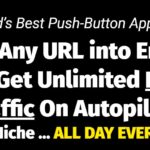If you want to create content for your blog that really produces great results (i.e., sales!), then you need to use Jimmy D. Brown’s strategy for creating “useful yet incomplete” content.
What, exactly, does this mean?
Here it is in a nutshell…when content is useful, it keeps people engaged.
Good content impresses your readers, and it helps you to build trust and a good rapport with them (which is essential to generating sales).
When people take action on your content and get good results, they’re going to be eager to see what else you can do for them.
This brings us to the second part of this equation…
When content is incomplete – meaning it only solves part of the prospect’s problem – it gives you an opportunity to promote a more complete solution within the article.
Indeed, your content should naturally lead to a paid offer.
Free content is “useful, but incomplete” when it is genuinely helpful to the reader while pointing to paid content that further explains or enhances it.
So, with that in mind, let’s look at several specific examples of how to use different types of articles to apply this strategy…
How to Articles
There are three main ways you can create a useful yet incomplete how-to article that presells a product:
- Provide an overview of the steps. This is where you tell people what to do, but you don’t give them detailed instructions on how to complete each step. You can then promote a course or other infoproduct. For example, you might give people an overview of how to set up and monetize a blog, and then sell a course like the one you’re reading as the complete solution.
- Go in-depth on part of the process. Here you give complete details for one step and then promote a product that provides the details for the rest of the steps. For example, you might explain (in depth) how copywriters can profile their audience, but then you promote a copywriting course that teaches them how to craft the sales letter.
- Go in-depth on the entire process. Here you teach people everything they need to know about how to do something, and then presell a tool to help them do it. For example, you might teach people exactly how to craft an email follow-up series, and then promote a set of email templates and swipes to make it easier for them to complete the task.
Next…
Listicles
A listicle can take the form of a list of resources, ways, tips or other items.
Typically, you include images (such as GIFs) along with each point in your article.
By its very nature, listicles are incomplete because they don’t provide in-depth details, which gives you the perfect opportunity to promote the full solution.
For example, you might create a listicle called “10 Ways to Boost Your Metabolism,” and then sell a weight-loss book.
Another example: you might create a list of “must have” resources for membership site marketers, with one of those resources being a membership site script or plugin that you’re selling.
FAQ Articles
Here you compile a list of frequently asked niche questions (and of course, you create high-quality answers).
These might be questions that your readers send you or questions that you’ve seen people ask about on forums and in Facebook groups.
Your article will solve part of your prospect’s problem by offering valuable information, but then you can sell an info product, service or other product to solve the rest of their problem.
For example, you might post an article with questions and answers about how to set up a website. You can then offer your “done for you” service as the complete (and easy) solution for people who don’t want to do it themselves.
Review Articles
Many people like to read product reviews before they even think about purchasing a product.
They actually seek reviews out.
If you can provide thorough, trustworthy reviews, then you’re sure to generate sales as a result.
Here’s the key to crafting a good review…
List the good, the bad and the ugly.
You can handle any objections or perceived weaknesses, which will help generate more sales.
But the key is to be completely upfront, which increases trust… and sales.
Next…
Tools Posts
Still another type of post you can use to presell a product is the tools post.
Generally, your promoted product will help people make the most of the tool you gave them.
Check out these ideas:
- Worksheets. For example, you can offer prospects a budgeting worksheet, which will help prospects realize they need help with managing their income or reducing their debt. You can then sell a money-management course or a debt-management course.
- Checklists. A checklist gives people an overview of all the steps they need to take to complete a process (e.g., The Sales Letter Checklist). You can promote an info product that gives prospects in-depth how-to information.
- Cheat sheet. Here you provide lots of tips, steps and ideas, but once again prospects need to purchase an info product to get the complete details.
- Templates. Here you provide a template to help prospects achieve a task more easily (e.g., a sales letter template to make copywriting easier). You’d then promote an info product that helps prospects make the most of this template (such as a copywriting course).
Let’s wrap things up…
Your Turn
Now it’s your turn to plan out your preselling strategy using useful yet incomplete posts.
Do a little brainstorming right now by answering the following questions.
First, pick an offer you’d like to promote, and then answer these questions about that offer:
- What type of how-to post could you use to promote your offer?
- What kind of listicle could you create that would presell your offer?
- What sorts of questions could you answer (in a FAQ) that would help you sell the offer?
- Can you create a review of the offer? (This only works if the product doesn’t belong to you.)
- What sort of tools can you create that are related to the offer?
Again, to be clear, you want to provide free HIGH-QUALITY content at your blog that is GENUINELY HELPFUL (IE “useful”) in helping your readers solve problems, reach goals and/or enjoy interests.
When you take care of the foundational, the finances will take care of themselves!
Next> 7 Proven Best Practices For Running A Professional Blog










